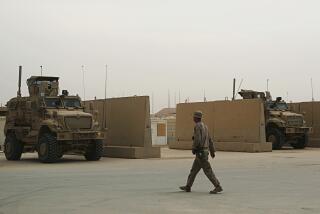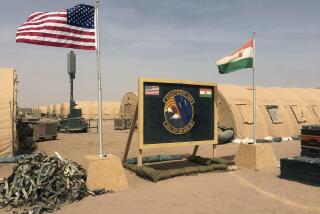U.S. Air Bases Forge Double-Edged Sword
WASHINGTON — Behind a veil of secret agreements, the United States is creating a ring of new and expanded military bases that encircle Afghanistan and enhance the armed forces’ ability to strike targets throughout much of the Muslim world.
Since Sept. 11, according to Pentagon sources, military tent cities have sprung up at 13 locations in nine countries neighboring Afghanistan, substantially extending the network of bases in the region. All together, from Bulgaria and Uzbekistan to Turkey, Kuwait and beyond, more than 60,000 U.S. military personnel now live and work at these forward bases. Hundreds of aircraft fly in and out of so-called “expeditionary airfields.”
While these bases make it easier for the United States to project its power, they may also increase prospects for renewed terrorist attacks on Americans.
The new buildup is occurring with almost no public discussion. Indeed, it has passed virtually unnoticed outside the region--in part because of operational security and force protection considerations in Afghanistan and in part because of agreements between Washington and host governments not to discuss the bases in public.
But the reasoning behind these agreements underscores the risk: Though Washington has obtained the support of the ruling regimes, including some inside the former Soviet Union, virtually all the bases are in countries where an American military presence stirs resentment among Islamic extremists.
“I swear to God that America will not live in peace before all the army of infidels depart the land of the prophet Muhammad,” Osama bin Laden said in his first video recording released after Sept. 11.
U.S. policymakers have tended to dismiss such statements as propaganda, but some analysts think they reflect widespread Muslim sensitivities that the United States has been slow to appreciate.
In the view not only of Bin Laden but also of many Islamic sympathizers, the continued presence of American forces in Saudi Arabia and other Arab states after the end of the Persian Gulf War in 1991 constituted “defilement” of Muslim holy places.
Without accepting this view as a justification for terrorism, some analysts believe U.S. officials underestimate the impact that prolonged stationing of American forces may have in the Muslim world--especially since it is highly visible there, though it has attracted little attention in the West. The Arab press in particular is filled with speculation and conspiracy theories about the ultimate purpose of the U.S. presence.
Many see it as evidence of an American desire for hegemony and control.
“The old basing structure, honed to fight the Soviet Union,” is gone, says defense analyst James Blaker, author of a seminal Pentagon study of overseas bases. “But does the new one open us up to counteractions?”
The American buildup in the region began long before Sept. 11, and it has been paralleled by a shift in the focus of terrorist groups.
As the United States built a network of facilities in a half-dozen Persian Gulf states after the Gulf War, terrorism increasingly focused on large U.S. targets, from the bombing of the Khobar Towers in Saudi Arabia and the destroyer Cole in Yemen to the attacks on the Pentagon and the World Trade Center.
In the words of novelist John le Carre, who has studied the Muslim world extensively and set some of his stories there, “What America longs for at this moment, even above retribution, is more friends and fewer enemies.”
Instead, “what America is storing up for herself is yet more enemies,” he said in an essay that appeared in the Toronto Globe and Mail. “Because after all the bribes, threats and promises that have patched together this rickety coalition, we cannot prevent another suicide bomber being born--and nobody can tell us how to dodge this devil’s cycle of despair, hatred and, yet again, revenge.”
Since the end of the Cold War, the U.S. military presence overseas has changed profoundly. A 1999 Army War College study found, “While permanent overseas presence has decreased dramatically, operational deployments have increased exponentially.”
The Pentagon pulled out of 700 facilities in Europe and abandoned the containment ring of bases around the old Soviet Union. In sheer numbers, it reduced the overseas presence to about 60% of what it was when Ronald Reagan took office.
Most of the numerical reduction took place in Germany, as forces were demobilized and the military shrank its Cold War size there by fully two-thirds.
The far more significant change, however, came in the way troops were used abroad. In earlier times, members of the armed forces were routinely “stationed” overseas, usually for tours of several years and often accompanied by their families. Now they are “deployed,” with the length of tour more uncertain and dependents almost never allowed.
The deployments are both frequent and lengthy, however. On any given day before Sept. 11, according to the Defense Department, more than 60,000 military personnel were conducting temporary operations and exercises in about 100 countries.
While the mammoth European installations have been cut back, Defense Department records show that the new operational mode calls military personnel away from home about 135 days a year for the Army, 170 days for the Navy and 176 days for the Air Force.
For the Army, each soldier now averages a deployment abroad once every 14 weeks.
Beyond the burdens it places on those involved, the new system draws the military into situations that are murkier and potentially riskier. Consider the case of Master Sgt. Evander Earl Andrews, the first American casualty of Operation Enduring Freedom. Andrews, an 18-year Air Force veteran, died in a construction accident. He was one of more than 2,000 civil engineers currently deployed in the region building and fixing up bases.
The Defense Department initially said Andrews was at a “forward deployed location” supporting the Afghanistan war. Eventually, it divulged that the location was Al Adid in the tiny state of Qatar on the Arabian Peninsula.
Al Adid is a billion-dollar base. Its 15,000-foot runway is one of the longest in the Gulf region. Construction began after an April 2000 visit by Defense Secretary William S. Cohen. Qatar already housed equipment for an Army brigade and, in 1996, hosted 30 Air Force fighters on an “expeditionary” deployment.
Though the original justification for Gulf bases such as Al Adid was preparedness for renewed action against Iraq, a senior defense official said last year that the Qatar facilities were “not focused at one particular country or another, but part of a system we would like to have in place.”
Issues of decision-making, jurisdiction and authority held by the host country are spelled out in documents called status of forces agreements. As of Sept. 11, according to Pentagon documents, the United States had formal agreements of this sort with Qatar and 92 other countries.
During the Cold War, the agreements were usually public documents. Many of the newer ones are classified, including those with Kuwait, Oman and the United Arab Emirates as well as certain supplements for Saudi Arabia. “Host nation sensitivities” require that the arrangements be secret, officials say.
To lower the U.S. military profile further, in most Gulf countries, permanent U.S. military and contractor personnel nominally work for organizations with innocuous-sounding names like the “Executive Coordinating Agency.”
That may blur the picture for Americans, but not for the local population. On Nov. 7, an attacker was shot and killed after exchanging gunfire with two U.S. military and one Qatari guard at Al Adid.
Since Sept. 11, new classified arrangements have also been established with Kyrgyzstan, Pakistan, Tajikistan and Uzbekistan, the four “stans,” as they are sometimes called. The United States had no military facilities or appreciable presence in these places before the World Trade Center and Pentagon attacks.
Typical is Uzbekistan, which very early on extended use of its Kandabad air base at Karshi for military and CIA operations. Journalists have descended on Uzbekistan since early October, but most report that the obvious American presence is not much of an issue for public discussion.
In this former Soviet province, national security secrecy is a way of life. The state-controlled press of President Islam Karimov has said the base is a staging area for search-and-rescue missions and humanitarian work in Afghanistan. The Pentagon sidesteps discussion of Uzbekistan’s human rights record or the implications of the U.S. presence, saying that it leaves it to the host nation to describe its cooperation with the United States.
Central Command chief Tommy Franks and Defense Secretary Donald H. Rumsfeld have been frequent visitors to the “stans.” They are like the hood ornaments on a big truck:
In November a Central Command assessment team landed in Tajikistan to examine three military installations as possible areas to base U.S. troops: Kulyab, Khojand and Turgan-Tiube. Tajikistan is about 85% Muslim.
Just prior to Christmas, engineers arrived at Manas airport in Bishkek, Kyrgyzstan, to open the airfield for U.S. use. Facilities for up to 3,300 personnel are being created. Kyrgyzstan also has a largely Muslim population.
How long will the United States remain? The answer, officials suggest privately, recalls the old wartime song, “Over There.” The song ended, “And we won’t be back till it’s over over there.”
No one inside the Pentagon or at Central Command headquarters has a timetable or master plan for when U.S. forces will withdraw, but it may be instructive to recall that the Persian Gulf bases have now been occupied for more than a decade. They were constantly upgraded and improved during the 1990s, setting the stage for the current deployments. The process went forward on a largely ad hoc basis, focused on practical arrangements and conditions in each country.
Then, as now, what seems to have been missing was a broad conceptual view of what the whole effort might add up to, or what its more distant implications might turn out to be.
More to Read
Sign up for Essential California
The most important California stories and recommendations in your inbox every morning.
You may occasionally receive promotional content from the Los Angeles Times.










